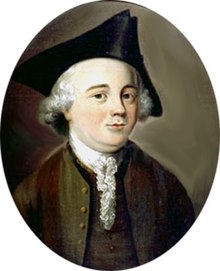John Kay (flying shuttle)
| John Kay | |
|---|---|

Portrait, said to be of John Kay in the 1750s, but probably of his son, "Frenchman" John Kay.
|
|
| Born | 17 June (N.S 28 June) 1704 Walmersley, Bury, Lancashire, England |
| Died |
circa 1779 France |
| Nationality | English |
| Occupation | Inventor |
| Known for | Flying shuttle |
| Spouse(s) | Anne Holte |
| Children | Lettice, Robert (drop box inventor), Ann, Samuel, Lucy, James, John, Alice, Shuse, William, (and two other children who died in childhood) |
| Parent(s) | Robert Kay and Ellin Kay, née Entwisle |
John Kay (17 June 1704 – c. 1779) was the inventor of the flying shuttle, which was a key contribution to the Industrial Revolution. He is often confused with his namesake, who built the first "spinning frame".
John Kay was born on 17 June 1704 in the Lancashire hamlet of Walmersley, just north of Bury. His yeoman farmer father, Robert, owned the "Park" estate in Walmersley, and John was born there. Robert died before John was born, leaving Park House to his eldest son. As Robert's fifth son (out of ten children), John was bequeathed £40 (at age 21) and an education until the age of 14. His mother was responsible for educating him until she remarried.
He apprenticed with a hand-loom reed maker, but is said to have returned home within a month claiming to have mastered the business. He designed a metal substitute for the natural reed that proved popular enough for him to sell throughout England. After travelling the country, making and fitting wire reeds, he returned to Bury and, on 29 June 1725, both he and his brother, William, married Bury women. John's wife was Anne Holte. His daughter Lettice was born in 1726, and his son Robert in 1728.
In Bury he continued to design improvements to textile machinery; in 1730 he patented a cording and twisting machine for worsted.
In 1733, he received a patent for his most revolutionary device: a "wheeled shuttle" for the hand loom. It greatly accelerated weaving, by allowing the shuttle carrying the weft to be passed through the warp threads faster and over a greater width of cloth. It was designed for the broad loom, for which it saved labour over the traditional process, needing only one operator per loom (before Kay's improvements a second worker was needed to catch the shuttle).
...
Wikipedia
